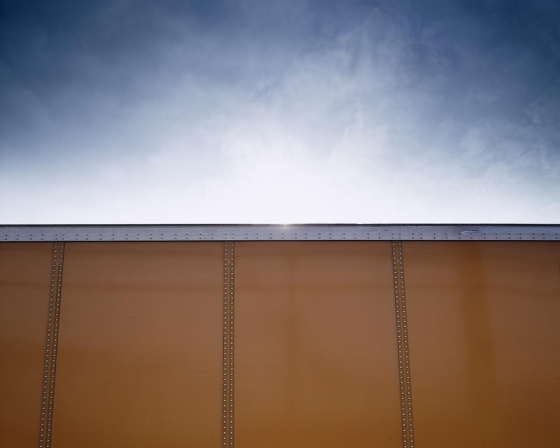
The concept of walls and borders has been tossed around with such frequency of late, and with such politically charged implications, it seems almost anticlimactic that artists would address this notion within a primarily aesthetic context. Counterpoints to the Narrative curated by D. Dominick Lombardi, features a group of artists exploring ideas that are simple, yet provocative, visuals of this complex subject matter. Sparky Campanella, Mark Sharp, and Martin Weinstein, two painters, one photographer, whose work, seen in combination is much more than a contrast in method and style; rather, it is a meditation on visuality and viewership. These artists are creating work that explores some of the ideas Rudolf Arnheim has put forth regarding the contrast between "seeing into" a work of art, and "seeing as."
Lombardi's recent article on these artists succinctly outlines their individual projects with great clarity. What is also worth considering is how their work works in concert, each artist presenting salient ideas around their individual media, and how, in our current, saturated visual environment, we perceive this work. Campanella's large-format photographs, with their strict geometries, most clearly show how we, as viewers, address such imagery. His simple, symmetrically bifurcated photographs of walls, architecture, etc., present elements, that fall somewhere between Eggleston and Gursky. They are devoid of human elements, but the architectural references suggest that there is a sense of human presence, though it is occluded from our view. We, the viewers, by nature of our vantage point, are outside the action. How we see these straightforward compositions is similar to how we perceive a great deal of abstract painting. In the case of Waterworks Drive (2014) (image above), its landscape format suggests Ad Reinhardt or a late Rothko. It has been noted by psychologists that when confronted by such minimal information, we tend to project a figure on the upright -- a landscape with the horizontal. It would be simplistic to reduce all visual depictions in such binary categories, but here, in these desolate vistas, we feel the sense of searching that Campanella's work suggests.
Mark Sharp's painted, stained, and sewn collage-like paintings -- a cross between Helen Frankenthaler and Lucas Samaras -- is a Magic Colored Dreamboat, urban camouflage, or tie-died colorfield banner. They give us a different type of border, fabric, which is usually categorized with clothing, upholstery, or “artisanal” work -- tapestry and such. Like Lucas Samaras, Sharp conflates art forms usually associated with "women's work," such as sewing, quilting, needlepoint, and combine them with "heroic" style Ab-Ex or German Expressionist painting. Sharp’s combination of high-and-low also expresses something human-scale, letting the work convey a feeling of clothing -- that protective veil that we have culturally acquired, that defines us, that often unites and separates simultaneously.
Martin Weinstein, in paintings such as Kenton, 2 Winter Sunsets (2017), most clearly illustrates Lombardi's visual thesis. Weinstein paints traditional plein aire type paintings. Rendered with a light touch, they are both landscape paintings and an almost archetypal notation for "landscape" simultaneously. The presentation, the literal framing of the works, gives these pictures a conceptual twist. Framed in polyvinyl carbonate, the synthetic "glass" in the vitrines of such blue chip sculptures by Damien Hirst, Matthew Barney, and Jeff Koons, they also suggest a more urban set of connotations. PVC, or bulletproof glass, is also the framing device we find in liquor stores, check cashing places, the OTB concession, or the late-night bodega. We see the bucolic landscape through a city window. In many ways, this is the counterpoint to the traditional narrative in painting. Painting once served as a window to an imaginary world, one in which the artist drew the viewer into his story the way a film director does now. These works, however, exemplify Robert Rauschenberg's notion that his paintings were "an invitation to look somewhere else."
Weinstein, Campanella, and Sharp have created work that deals in tension -- the tension between the eye and the mind, between perception and thought. They invite us to look, and dare us to look away. - Bradley Rubenstein
